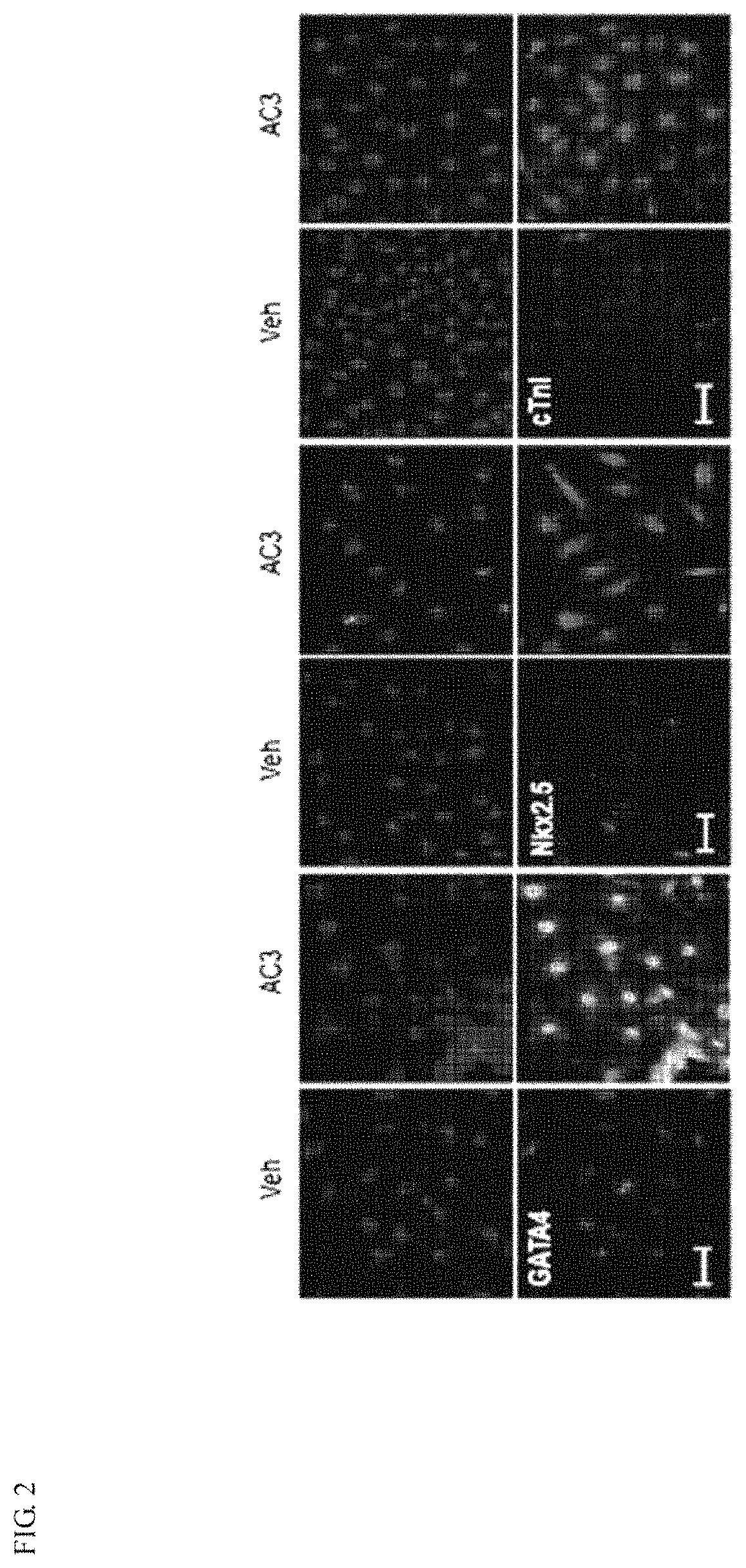Apicidin-containing composition for inducing differentiation of mesenchymal stem cells into cardiac-committed cells
a technology of stem cell differentiation and apicidin, which is applied in the field of apicidin composition for inducing the differentiation of mesenchymal stem cells, can solve the problems of low engraftment of stem cells in heart tissue, loss of viability, and limited research on regeneration of lost cardiomyocytes, so as to improve the survival rate and engraftment rate of stem cells, the effect of low cardiomyogenic differentiation efficiency
- Summary
- Abstract
- Description
- Claims
- Application Information
AI Technical Summary
Benefits of technology
Problems solved by technology
Method used
Image
Examples
example 1
and Culture of Human Bone Marrow-Derived MSCs
[0049]The bone marrow harvested from a human was diluted with phosphate buffered saline (PBS) at a volume ratio of 1:1 and overlaid on a Ficoll-Hypaque solution (Ficoll-Hypaque, density of 1.077 g / mL, Sigma). Here, the Ficoll-Hypaque solution was kept at room temperature before use, and the volume of the diluted bone marrow was controlled not to exceed 3 times the volume of the Ficoll-Hypaque solution. The diluted bone marrow was centrifuged at a speed of 2,000 rpm for 30 minutes at room temperature, and thus was separated into a red blood cell layer, a mononuclear cell layer and a serum layer. Only the mononuclear cell layer was transferred to a fresh tube using a Pasteur pipette, which was then washed with PBS to remove the Ficoll-Hypaque solution included in harvesting of the mononuclear cell layer or contaminated platelets. This state is called a “mononuclear cell,” and to separate and amplify MSCs therefrom, the mononuclear cells wer...
example 2
n of Expression of Myocardium-Specific Marker Genes by HDAC Inhibitors
[0051]To comparatively evaluate whether the apicidin (AC) of the present invention significantly induces the expression of cardiac-specific marker genes (GATA4, Nkx2.5 and cardiac troponin I (cTnI)), compared with trichostatin A (TSA) and valproic acid (VPA), which are widely used as conventional HDAC inhibitors, real-time PCR was performed.
[0052]First, MSCs prepared in Example 1 were cultured for one day in a 6-well culture plate containing HIGH glucose / DMEM (4 mM L-glutamine, 4500 mg / L glucose, sodium pyruvate, 10% FBS, 100 U / ml penicillin, 100 μg / ml streptomycin), and then treated with TSA (0.5 μM), VPA (3 mM), and AC (1 and 3 μM) for 24 hours.
[0053]Afterward, the cell culture medium was removed from each sample, washed with PBS once, and homogenized with TRIzol for 10 minutes at room temperature, followed by centrifugation after the addition of chloroform. A supernatant obtained by centrifugation was harvested...
example 3
of Expression of Myocardium-Specific Marker Protein by Apicidin
[0055]According to Example 2, since it was confirmed that treatment of apicidin (3 μM) provided a most excellent effect of inducing cardiomyogenic differentiation, to further analyze the protein expression of cardiomyogenic differentiation markers by apicidin (3 μM), immunocytochemistry was performed.
[0056]First, MSCs were cultured in a 12-well culture plate containing HIGH glucose / DMEM overnight and then treated with 3 μM of AC for 24 hours. Then, the cell culture medium was removed from the sample, and then the cells were washed with PBS once, immobilized on a 3.7% mask foam for 15 minutes to be penetrated with 0.1% Triton X-100 for 10 minutes. After blocking with normal goat serum for 1 hour, the cells were cultured with anti-GATA4, anti-Nkx2.5 and anti-cTnI primary antibodies at 4° C. overnight, and treated with a secondary antibody labeled with a fluorescent dye (Alexa 488, Alexa 594) for 1 hour. After nuclear stain...
PUM
| Property | Measurement | Unit |
|---|---|---|
| density | aaaaa | aaaaa |
| concentration | aaaaa | aaaaa |
| thickness | aaaaa | aaaaa |
Abstract
Description
Claims
Application Information
 Login to View More
Login to View More - R&D
- Intellectual Property
- Life Sciences
- Materials
- Tech Scout
- Unparalleled Data Quality
- Higher Quality Content
- 60% Fewer Hallucinations
Browse by: Latest US Patents, China's latest patents, Technical Efficacy Thesaurus, Application Domain, Technology Topic, Popular Technical Reports.
© 2025 PatSnap. All rights reserved.Legal|Privacy policy|Modern Slavery Act Transparency Statement|Sitemap|About US| Contact US: help@patsnap.com



